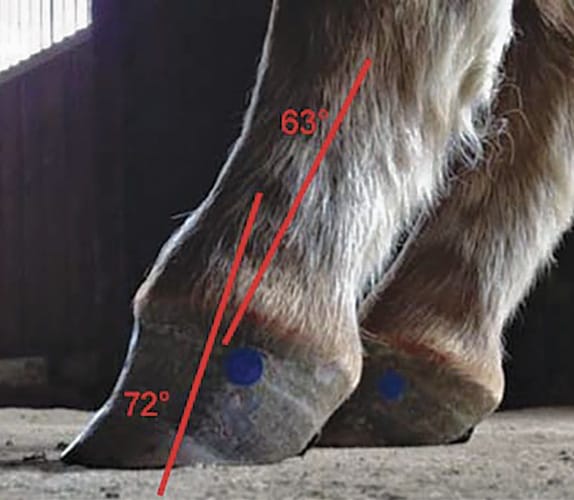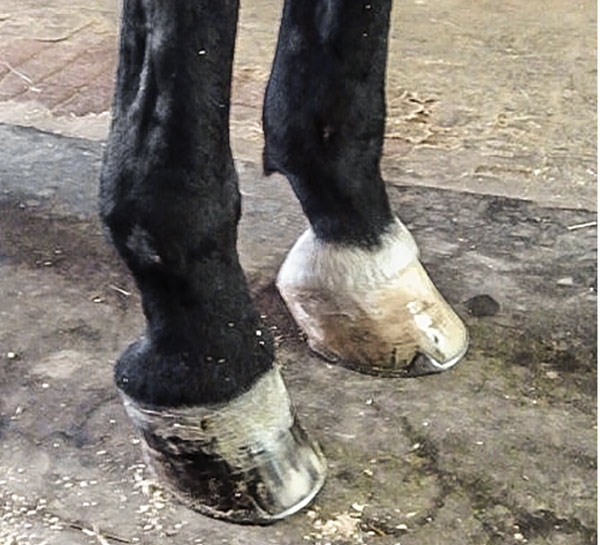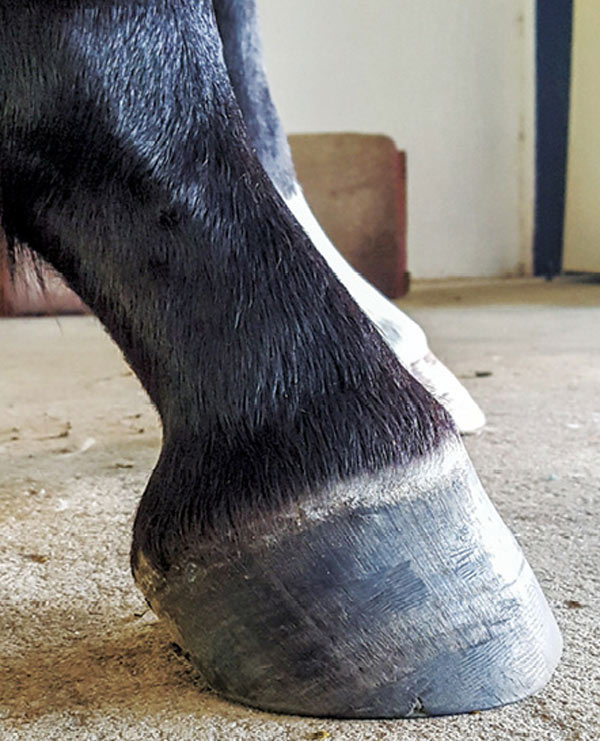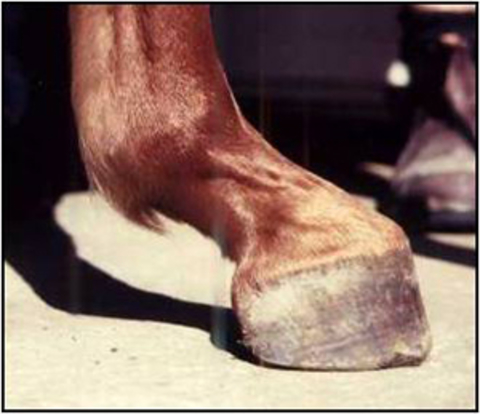club foot horse cause
If either of the parents or their other children have had clubfoot the baby is more likely to have it as well. Horses affected with club foot develop a flexural deformity of the coffin joint due to a shortening of the musculotendinous unit that starts high up in the limb and inserts on the coffin bone in the foot resulting in an upright conformation of the foot.
Club Foot In Horses Equine Chronicle
Causes of Club Foot in Horses The deep flexor tendon is shorter than the bones causing a pulling on the coffin bone in the hoof which causes a deformity in the shape of the hoof Congenital deformity at birth occurring within the mares uterus likely due to multiple factors.
. It has even been said that horses which have a leaning posture or are in fact one-. Affected horses tend to land toe-first and their heels growth rate is amplified relative to the toes. The hoof angle becomes raised and the horse walks on his toe due to a shortening of the musculotendinous unit the unit including.
A diet rich in calories and sugar can cause problems as well. Telltale signs of a club foot may include an excessively steep hoof angle a distended coronary band growth rings that are wider at the heels contracted heels and dished toes. Caused by abnormal contraction of the deep digital flexor tendon a club foot puts pressure on the coffin joint and initiates a change in a hoofs biomechanics.
Club foot is one of the most common deformities in the horse world. A horse with a club foot is kind of like a horse in high heels. A clubbed foot it a contracted tendon meaning that the leg with the club will not be able to reach as far.
Club foot can occur before or after birth in foals. FIVE POTENTIAL CAUSES There are several theories on what can cause a club foot to occur. The number one cause of a clubbed foot is genetic with OCD problems falling as the second-leading cause and a distant third cause being a bad case of ephiphysitis.
This condition usually is discovered in young horses when they are about four to six months of age. Cause it bears little resemblance to the clubfoot de-formity in children referred to as congenital talipes equinovarus45 Presumably the term was coined to describe the upright or straight tubular appear-ance of the foot where there is little expansion of the hoof capsule giving a club-like appearance but. The un-evenness in the stride and musculature will cause lameness because generally there is more stress placed on the club.
The differences in growth rates that cause club feet could be the result of a number of factors including too rapid growth diet imbalances inappropriate exercise traumatic injury and inflammatory responses. What Can You Do About Uneven Hoof Growth. Often club foot affects both front legs with one being more severe than the other.
The equine club foot is defined as a hoof angle greater than 60 degrees. Several theories address the potential causes ranging from a genetic predisposition to hoof or body injury to. Risk factors Boys are about twice as likely to develop clubfoot than girls are.
Very often pathologically upright hooves are caused by a horse moving to avoid pain. A foals bones growing. A club foot alters a horses hoof biomechanics frequently leading to secondary lamenesses.
It is usually impossible to get into a discussion of what has caused the club foot as the owners of both sire and dam will vigorously deny that any history of club. The brutal truth is NO a club foot cant be fixed and YES it will be a club foot for life. A club foot results from a flexural deformity of the distal interphalangeal joint that is characterized by a shortening of the deep digital flexor tendon musculotendinous unit.
The actual hoof will also be a size or two smaller than the other and a different shape. Any event that leads the young horse to load its weight unequally on its front limbs puts a foal at risk for developing deformities. Although club foot triggers numerous unusual indications it mostly does not cause any pain or discomfort by itself.
However with increasing age the child affected by club foot is more predisposed to health complications such as arthritis limited flexibility in feet with difficulty walking normally abnormal gait and manner of standing. Club foot can occur before or after birth in foals. The result of this will often be increased musculature on the club side.
If a horse has a clubbed foot then the foals that mare or stud produces will have one as well. Foaling trauma foal grazing stance overly fast growth of limbs injury or even something as benign as over zealous cosmetic trimming of the toes of. Unless there is a bony deformity of the foot that is causing the bone to be misshapen these cases are caused by soft tissue contraction from limited range of motion andor weight bearing in the affected limb.
Club foot refers to a tendon flaw that causes the hoof to be very upright. Club feet are surprisingly common with up to 60 of the domestic horse population exhibiting at least minor characteristics. Club foot can develop in mature horses too for similar reasonsany injury or chronic pain that causes a horse to consistently favor one foot can lead to contracting and shortening of the muscles and tendons specifically the deep digital flexor tendon and muscle apparatus in that leg eventually pulling the foot into a more upright position.
After birth foals acquire club feet when the bones grow faster than the tendons. A club foot may also result from injury if the horse is lame and keeps favoring the sore foot not putting much weight on the heel. The primary one is genetics.
Therefore the term club foot in horses does not apply in these cases. Causes include nutritional issues heredity position in the uterus or injury. This lack of use may cause shortening and contracting of the muscles and tendons in that leg eventually making that foot more upright.
Club foot has several possible causes. Flexural deformities are a problem not only in foals but are also responsible for the club foot conformation seen in. The cause of clubfoot is unknown idiopathic but it may be a combination of genetics and environment.
What we see externally as the equine clubbed foot is actually caused by a flexural deformity of the distal interphalangeal joint coffin joint. Causes include nutritional issues heredity position in the uterus or injury. There are several causes of club foot.

Defining And Fixing A Horse S Club Foot

What Advice Has Been Most Helpful When You First Encounter A Club Foot

Club Foot Or Upright Foot It S All About The Angles
Is This A Club Foot Horsetalk Co Nz


